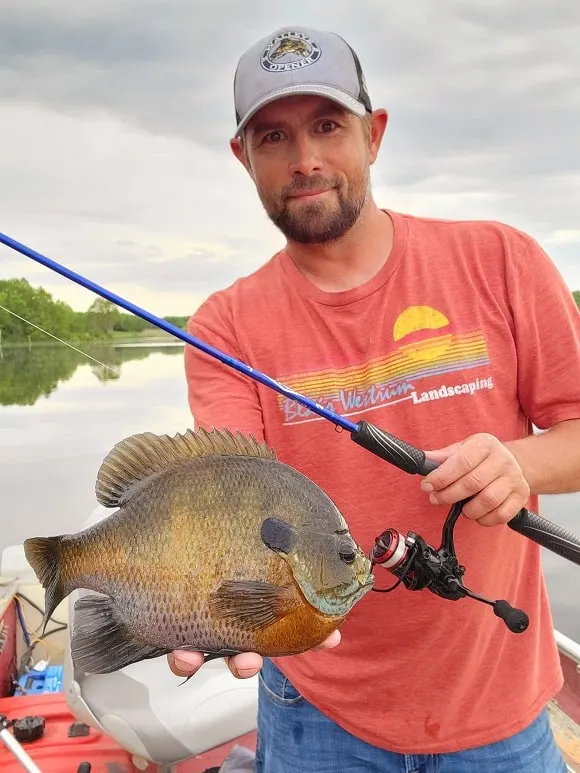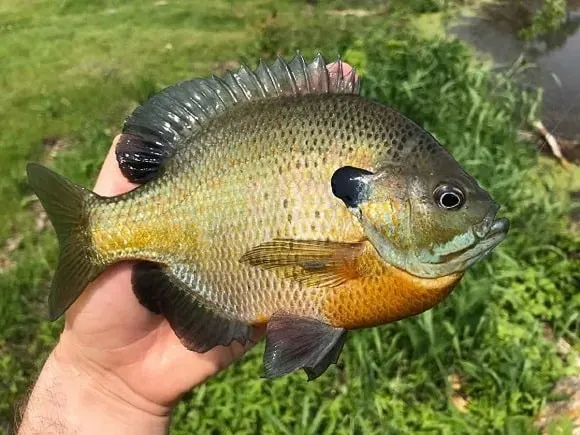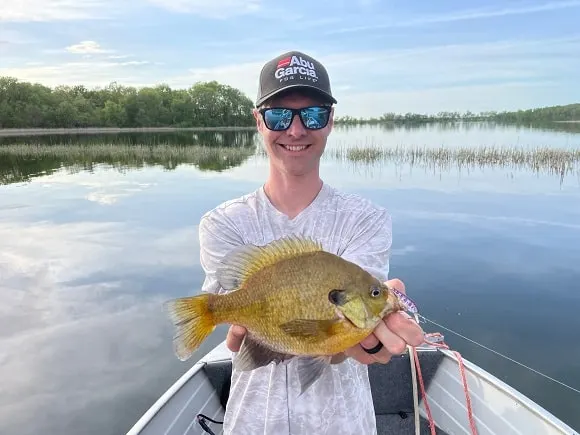Warm weather means it’s time to get fishing for bluegills! This panfish species is a popular game fish all over America, and millions of anglers enjoy fishing for it.
Generally speaking, bluegills like warm water. But is there more to it than that? How do different weather conditions affect this fish species?
Bluegills are most active during and after the spawn when the water has a temperature of approximately 55 to 75°F. The fishing for bluegill is often at its best on days with a light to moderate breeze, a slowly falling barometer, and a slightly overcast sky.
Keep reading this article and find out everything there is to know about the optimal weather conditions for bluegill fishing.
Best Weather Conditions for Bluegill

Water temperature and wind intensity are the most important weather conditions for bluegill fishing!
The best fishing months for bluegill are usually May, June, and July, before, during, and after the spawn.
So, if you get the water temperature right during these months, you’ve got a good chance of catching lots of gills!
Wind direction and strength can also play a vital role, especially if you’re fishing from a boat.
Other weather conditions, like barometric pressure, light intensity, and cloud cover, are usually less important but can still make a difference when targeting gills.
Let’s take a closer look at all of these weather factors!
Temperature
The bluegill’s spawning period typically stretches from late spring through summer.
It occurs in water temperatures of approximately 55 to 75°F, which is the same temperature range you need to look for to have a good bluegill fishing trip.
Once the shallows reach a water temperature of 55 to 60°F, the bluegills will enter the scene and get ready for spawning.
It is now that you can both locate them very easily and catch them successfully, as they feed actively in such water temperatures.
The spawn can last till mid or even the end of summer and occurs in water temperatures as high as the mid or high 70s.
Such a wide temperature range gives you plenty of time and opportunity to catch bluegills, which is why they are such a popular game fish during summer. If you’re lucky, the bit rarely never stops!
On the other hand, water temperatures lower than 50 or higher than 80°F aren’t optimal.
Even though you can catch bluegill year-round, the fish will be noticeably more sluggish in very cold or warm water.
Additionally, the fish will seek deeper water when the shallows are too cold or hot, making locating them significantly more difficult.
Wind
Wind direction and strength is the second most important weather feature for bluegill fishing.
While the bite can be on regardless of wind direction, southern or western winds are generally more favorable than northern or eastern winds.
However, wind intensity is much more important, considering you’re fishing the shallows. And especially when fishing from a boat.
A light to moderate breeze is what you want when fishing for bluegills in shallow water!
Locating the fish can be much harder in strong winds. Waves can break the water’s surface, making it extremely difficult to see what’s happening beneath.
Strong winds also mean plenty of water movement, increasing turbidity in shallow water, making it even more challenging to locate the fish.
Furthermore, a windy day on the water can make precise finesse fishing with small lures or baits more than challenging.
Cloud Cover
Bluegills are sight feeders that rely on daylight when feeding. But as they’re also prey for big predators like pike, musky, bass, or walleye, they generally keep away from areas with too much light or visibility.
That’s why a lightly overcast day is often best when fishing for bluegill.
Less sunlight hits the water, meaning the fish have some cover and can roam and feed more freely.
On the other hand, a light cloud cover still allows for some visibility underwater, so the fish remain feeding actively, as they can see their forage.
Visibility and cover-wise, it’s the perfect goldilocks-scenario for gills; not too bright or dark!
With that said, fishing for bluegill during bright sunshine can also be very productive, as long as you’re fishing close to heavy cover!
Barometric Pressure
Barometric pressure can affect many fish species significantly, but the bluegill isn’t one of them.
Panfish species, in general, are not affected much by changes in barometric pressure. I guess that’s because of their smaller body and swim bladder size.
Their swim bladder doesn’t contain much gas, so they can regulate its volume against the changing pressure easier than bigger fish species.
As a rule of thumb, though, a slowly falling or stable low-pressure system is never bad for fishing!
On the other hand, a rapidly falling or rising barometer or a consistent high-pressure system can impact fishing negatively or even turn the bite off completely.
Is Rain Good for Bluegill Fishing?

Light rain can turn the bite on quickly. Heavy rain, on the other hand, should be avoided completely when fishing for bluegill.
Especially during the warmer months of the year, a light drizzle can have several positive effects on fishing:
- provides the lake or river with colder, oxygen-rich water
- lightly increases turbidity
- flushes insects from trees or shore into the water
What light rain does for the bluegills is to make them more active, give them lower underwater visibility and some cover, and provide them with food.
All that means that bluegill often feed and bite extremely well during and after a drizzle.
On the contrary, heavy rain creates too much turbidity and makes the water muddy and stained, which can make catching gills much more difficult.
Additionally, fishing in heavy rain isn’t much fun for you either, as you’ll get wet and cold.
RELATED ARTICLE: Bluegill Fishing in Muddy Water (A Helpful Guide)
Do Bluegill Bite in Cold Weather?
While bluegills love warm water and will be most active in it, they’ll still have to feed during the year’s cold months.
In fact, ice fishing for bluegill can be very productive if the conditions are right and you manage to locate the fish.
Of course, they won’t be nearly as active and hungry as during spring and summer, so you’ll have to find the feeding windows when targeting them during winter.
Another thing with cold water bluegills is that they are most often found in deeper water, where it’s a little warmer during winter.
RELATED ARTICLE: How to Catch More Bluegills in Clear Water
Do Bluegill Like Hot Weather?

Bluegills also keep feeding during the dog days of summer, when water temperatures go beyond 80°F.
The fish will most likely be a lot more sluggish, and it can be a lot harder to get them to take your bait, but it is possible to catch them!
Due to the often high temperatures and intense sunlight during the daytime, the water will get hot and hold much less oxygen. That, in turn, makes the fish sluggish and the fishing slow.
An easy way around this is to go fishing during the early and late hours of the day when the sun is low and the water temperature somewhat lower.
You should also try targeting deeper water during high summer, as it’ll be somewhat cooler down there.
Similarly, you should try to locate heavy cover and shady areas, such as weeds, reeds, overhanging trees and bushes, brush piles, bridges, etc. Anything that can provide shade!
Related Articles
- What Time of Year Do Bluegill Spawn?
- What Is the Best Fishing Line for Bluegill?
- What Is the Biggest Bluegill Ever Caught?
Featured image courtesy of Dan Spengler

